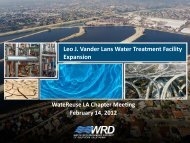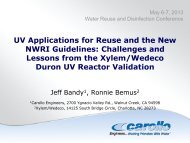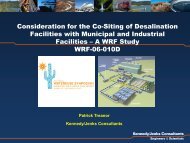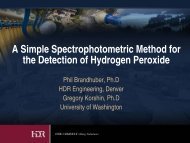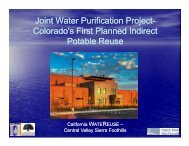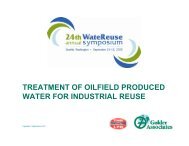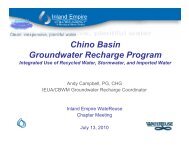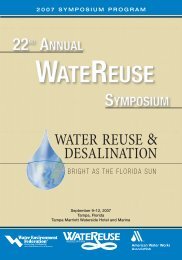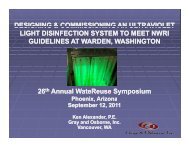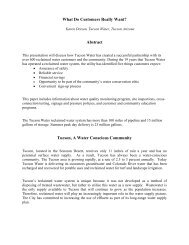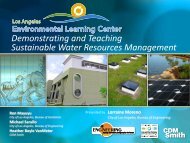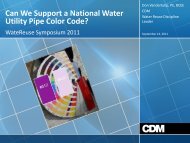Oxnard GREAT Program - WateReuse Association
Oxnard GREAT Program - WateReuse Association
Oxnard GREAT Program - WateReuse Association
Create successful ePaper yourself
Turn your PDF publications into a flip-book with our unique Google optimized e-Paper software.
<strong>Oxnard</strong> <strong>GREAT</strong><br />
<strong>Program</strong><br />
Scott Lynch, CH2M HILL<br />
California Section<br />
Conference<br />
<strong>WateReuse</strong> <strong>Association</strong><br />
San Francisco, CA<br />
March, 2009
Acknowledgements<br />
• Mary Vorissis/CH2M HILL<br />
• Ufuk Erdal/CH2M HILL<br />
• Jim Lozier/CH2M HILL<br />
• Jim Bays/CH2M HILL<br />
• Stephen Lyons/CH2M HILL<br />
• Ken Ortega/City of <strong>Oxnard</strong><br />
• Tony Emmert/City of <strong>Oxnard</strong><br />
Water...Essential to Life, Past, Present,<br />
Future
Outline<br />
• History<br />
• Project Background<br />
• Advanced Water Purification Facility<br />
• Brine-Concentrate Management via Wetlands<br />
• Visitor Center and Public Education<br />
Water...Essential to Life, Past, Present,<br />
Future
Project Location<br />
Water...Essential to Life, Past, Present,<br />
Future
WATER SUPPLY VS. DEMAND
Groundwater Basins
Groundwater Basin Overdraft<br />
• Declining Water<br />
Levels<br />
• Seawater<br />
Intrusion<br />
• 1st suspected in<br />
1931<br />
• USGS Model<br />
indicated 1927
Seawater Intrusion
“Necessity is the mother of invention…”<br />
roundwater<br />
ecovery<br />
nhancement<br />
nd<br />
reatment
Water...Essential to Life, Past, Present,<br />
Future
<strong>GREAT</strong> <strong>Program</strong> Benefits<br />
‣ Reduces Ocean Discharges from City of<br />
<strong>Oxnard</strong>’s Wastewater Treatment Plant<br />
‣ Provides Municipal & Industrial Recycled<br />
Water for Landscape Irrigation and Industrial<br />
Processes<br />
‣ Provides Agricultural Irrigation Water<br />
‣ Provides Water Suitable for Groundwater<br />
Injection to Repel Seawater Intrusion
<strong>GREAT</strong> <strong>Program</strong> Desalter Facility<br />
• Groundwater Desalter for<br />
Municipal Wells<br />
• Maintains Blended Water<br />
Quality Objectives<br />
• Phase I - 7.5 mgd<br />
• Ultimate - 15.0 mgd<br />
• Phase I Built in 2008
<strong>GREAT</strong> <strong>Program</strong> Advanced Water<br />
Purification Facility (AWPF)<br />
• Provides Advanced Treatment for Water<br />
Reuse<br />
• Phase I - 6.5 mgd<br />
• Ultimate - 25.0 mgd<br />
• Phase I Design Being Completed in 2009
Source of Water to AWPF<br />
• City of <strong>Oxnard</strong> WPCF<br />
• Secondary Effluent<br />
• BOD and TSS - 250 mg/L<br />
• TDS - 1700 mg/L<br />
• Composition<br />
• 75% Domestic<br />
• 25% Industrial<br />
• Disposal - Into Pacific Ocean via 48”<br />
diameter outfall: 5950’ long and 60’ deep
WPCF and AWPF Flows<br />
• WPCF<br />
• Design Capacity ~31.7 mgd<br />
• Present Flow ~22.6 mgd<br />
• AWPF<br />
• Phase 1<br />
• Approx. 8.0 mgd to AWPF<br />
• 6.25 mgd Product Water<br />
• Phase 2/Buildout<br />
• Approx. 30 mgd to AWPF<br />
• 25 mgd Product Water
Water Reuse<br />
Phase I<br />
- Municipal Users<br />
- Existing Irrigation Lines<br />
Future Phase<br />
- Seawater Intrusion<br />
Barrier
Irrigation Quality Requirements<br />
• Tertiary Quality to meet:<br />
• Food crops<br />
• Parks and playgrounds<br />
• School yards<br />
• Residential landscaping<br />
• Unrestricted access golf courses<br />
• Any other irrigation use not specifically<br />
prohibited<br />
• Filtered Wastewater<br />
• Section 60301.320<br />
• Disinfected Tertiary Recycled Water<br />
• Section 60301.230
Groundwater Quality Requirements<br />
• Health Laws Related to Recycled Water<br />
• Title 22 – Water Recycling Criteria<br />
• Title 17 – Cross Connection Criteria<br />
• Draft Groundwater Recharge Reuse Regulations<br />
• NPDES Permit
AWPF - Process Flow Schematic<br />
MF
MF/UF – Target Contaminants<br />
Secondary<br />
Effluent<br />
Contaminants<br />
REJECT<br />
• Turbidity<br />
• Inorganics<br />
• Virus<br />
Microfiltration<br />
Reverse Osmosis<br />
UV/AOX<br />
Reclaimed<br />
Water<br />
• Bacteria<br />
• Protozoa<br />
• Organics<br />
• CECs<br />
Removal<br />
<br />
Turbidity<br />
• Inorganics<br />
• Virus<br />
<br />
Bacteria<br />
<br />
Protozoa<br />
• Organics<br />
• Partial Removal<br />
o<br />
CECs
RO – Target Contaminants<br />
Secondary<br />
Effluent<br />
Contaminants<br />
REJECT<br />
REJECT<br />
• Turbidity<br />
• Inorganics<br />
• Virus<br />
Microfiltration<br />
Reverse Osmosis<br />
UV Disinfection<br />
Reclaimed<br />
Water<br />
• Bacteria<br />
• Protozoa<br />
• Organics<br />
Removal<br />
Removal<br />
<br />
Turbidity<br />
<br />
Turbidity<br />
• Inorganics<br />
<br />
Inorganics<br />
• Virus<br />
<br />
<br />
Bacteria<br />
Protozoa<br />
• Organics<br />
o CECs<br />
<br />
<br />
<br />
<br />
Virus<br />
Bacteria<br />
Protozoa<br />
Organics<br />
• CECs<br />
• Partial Removal<br />
• Highly Efficient Removal<br />
(Some compounds (NDMA, 1-4<br />
Dioxane) not removed)
UV/AOX - Target Contaminants<br />
Secondary<br />
Effluent<br />
Contaminants<br />
• Turbidity<br />
• Inorganics<br />
• Virus<br />
Microfiltration<br />
Reverse Osmosis<br />
UV/AOX<br />
Reclaimed<br />
Water<br />
• Bacteria<br />
• Protozoa<br />
• Organics<br />
• ECC<br />
• Partial Removal<br />
Removal<br />
<br />
Turbidity<br />
• Inorganics<br />
• Virus<br />
<br />
<br />
Bacteria<br />
Protozoa<br />
• Organics<br />
Removal<br />
<br />
<br />
<br />
<br />
<br />
<br />
Turbidity<br />
Inorganics<br />
Virus<br />
Bacteria<br />
Protozoa<br />
Organics<br />
• CECs<br />
Removal<br />
<br />
<br />
<br />
<br />
<br />
Turbidity<br />
Inorganics<br />
Virus<br />
Bacteria<br />
Protozoa<br />
Organics<br />
CECs<br />
• Highly Efficient Removal
Constructed Treatment Wetlands<br />
• Engineered natural systems that harness rich chemical,<br />
microbial, and physical processes found in natural wetland<br />
ecosystems<br />
• Known abilities to treat a wide variety of wastewaters:<br />
• Municipal<br />
• Agricultural<br />
• Stormwater / urban non-point source<br />
• Many industrial wastewaters<br />
• Numerous ancillary benefits<br />
• Habitat creation<br />
• Passive recreation and education<br />
• Low energy requirements
Natural Wetland Processes<br />
Engineered to Treat RO Concentrate<br />
N, Volatile<br />
Organics,<br />
Selenium<br />
Volatilization<br />
Surface<br />
Water<br />
Detritus<br />
Sediments<br />
Precipitation<br />
P, Metals<br />
Plant Uptake<br />
& Storage<br />
Metals, N, P<br />
Decomposition<br />
NO 3 , NH 3<br />
Nitrification /<br />
Denitrification<br />
Sedimentation<br />
Adsorption<br />
NH 3 , P,<br />
Metals,<br />
Organics<br />
Burial & Soil Storage<br />
TSS,<br />
Adsorbed<br />
Contaminants
Novel Application of Proven<br />
Technology<br />
• Treatment wetlands already known to treat<br />
contaminants of concern<br />
• Selenium<br />
• Nitrogen<br />
• Historical loss of wetland habitat and function<br />
creates desire for restoration and creation<br />
• Coastal tidal and salt marsh wetland<br />
communities tolerant of elevated TDS<br />
Wetlands may provide unique disposal solution with<br />
numerous ancillary benefits
Pilot Wetlands Project<br />
• 2 replicates of 6 technology types<br />
• Run for 3 years under multiple configurations<br />
• Significant removal of nutrients and heavy metals<br />
• Effluent generally not found to be toxic to indicator organisms
Horizontal Subsurface Flow
Vertical Flow
Surface Flow –<br />
Low Marsh
Deconstructive Sampling
Findings from 1 st Part of the Study<br />
• Ecosystem Viability<br />
• Healthy plant communities, fish<br />
• Water Quality Treatment<br />
• Nutrient/metals loss, net mass removal of virtually all<br />
measured parameters<br />
• Effluent is ecologically safe<br />
• Removal to below ecological thresholds for Se, NO 3<br />
• WET testing showed decreases in both acute and<br />
chronic toxicity to indicator organisms<br />
• Combination of systems in series can improve<br />
treatment efficiency
2 nd Phase<br />
of Study<br />
MF/RO Test<br />
facility at the<br />
<strong>Oxnard</strong> Wastewater<br />
Treatment Plant
Site for the Portable Wetland<br />
Water Quality Considerations<br />
• TDS – 11,000 mg/L<br />
• BOD – 100 mg/L<br />
•NH 4+ - 140 mg/L
Portable Subsurface Flow<br />
Constructed Wetland<br />
Surprises!<br />
• Free and<br />
combined chlorine<br />
in concentrate<br />
• Could kill plants<br />
and bacteria in<br />
wetlands<br />
• Added 6 mg/L of<br />
sodium bisulfite to<br />
inactivate chlorine<br />
Mobile Environmental Solutions<br />
Tustin, CA
AWPF Natural Treatment System Plan<br />
Surface Flow<br />
Wetland will polish<br />
final effluent, provide<br />
habitat and volume<br />
reduction through<br />
Evapo-transpiration<br />
Vertical Flow Wetland<br />
Cells will remove Selenium<br />
and Nitrate<br />
Visitor Center<br />
Treatment Train Applied to<br />
Demonstration Scale Facility with two<br />
parallel flow paths for additional testing<br />
and monitoring<br />
Horizontal<br />
Subsurface<br />
Flow Wetland<br />
Cells will remove<br />
Ammonia
Model of AWPF and<br />
Visitor Center<br />
Conference Center
Layout of AWPF<br />
Decarbonaters<br />
UV/AOX<br />
Chemical<br />
Storage<br />
RO<br />
MF<br />
Wetlands<br />
Visitor Parking
Visitor<br />
Center<br />
Decarbonater<br />
s<br />
MF<br />
Screens<br />
UV/A<br />
OX<br />
MF<br />
Units<br />
RO<br />
Units<br />
Chemical<br />
Storage
AWPF Visitor’s Center
AWPF Visitor’s Center
AWPF Visitor’s Center
AWPF Visitor’s Center
Water...Essential to Life, Past, Present,<br />
Future



